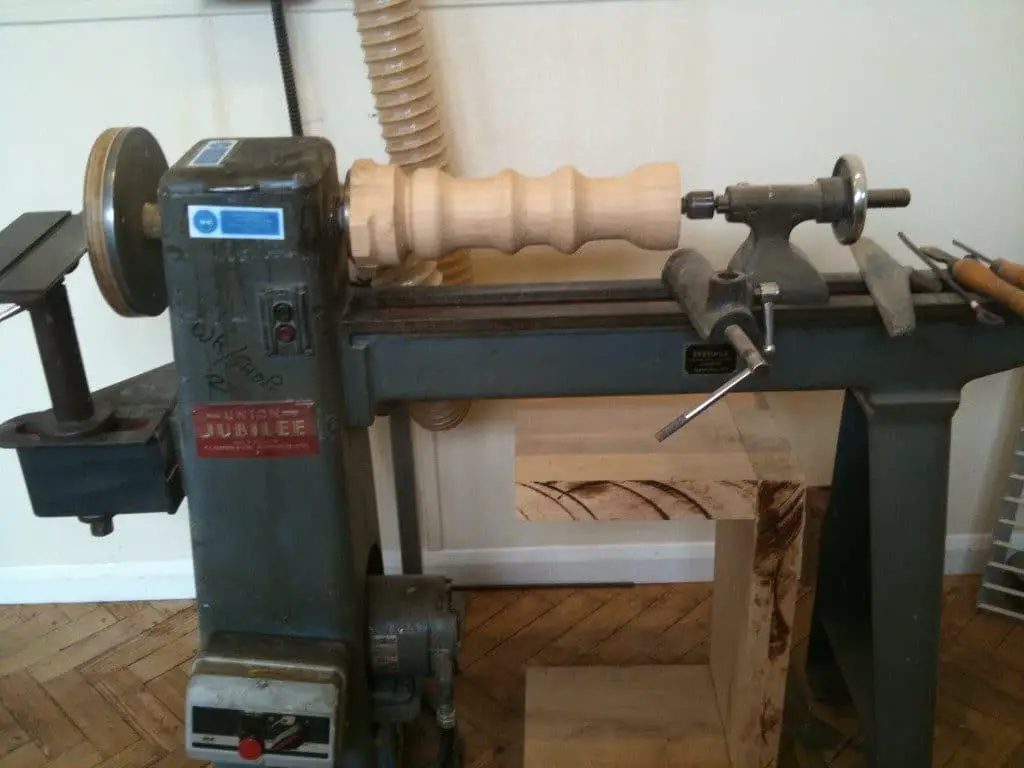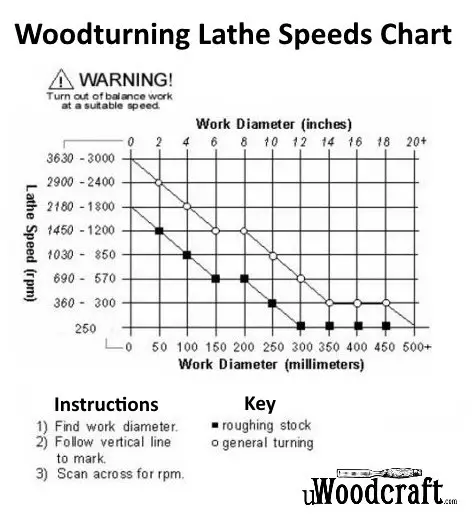Inappropriate lathe speeds for woodturning, (read that to mean going too fast) is by far the largest cause of accidents.
It has been said that good judgment comes from experience, and that experience comes from making mistakes.

But mistakes hurt, and I would like you to gain some of my experience without experiencing the pain!
Woodturning Lathe Speed Chart
Before we get into the details and explanations, here is a basic chart showing approximate recommended speeds for turning work of different diameters.

Now let’s get into the details…
Basic Factors of Turning Safety
There are basic safety factors in turning. Some of these factors are:
- The size of the project being turned
- The speed of the lathe
- The size of the lathe
- The method of holding the timber to the lathe
- The balance of the timber
- Proper tool handling
- Proper safety equipment
If we use good judgment with all of these factors then we can turn safely.
What are Lathe Speeds?
For this article I want to start off by looking closely at “How fast are you going?”, and the important considerations that go with speed.
First of all what does that question mean? How fast is the wood traveling?
There are two parts to this answer.
The first part of the answer is the RPM (revolutions per minute) that the lathe is running.
The second part of the answer is how large is the diameter of the turning.
Most lathes from the store have a range of about 580 to 2850 RPM.
Usually, there is a chart on the front of the lathe to tell you what RPM you will get from the different step pulley arrangements.
There are many situations where this speed range is way too high for safety.
An additional problem is that very often lathes have been modified with different size pulleys or variable speed motors.
Although it is possible to use different formulas to calculate the resulting RPM after these modifications, most people do not want to go through the math calculations.
(So I am not going to give you any math formulas. Instead I am going to give you something easier- a Tachometer!!!)
The Tachometer
For about six months I searched for an inexpensive tachometer to put on my lathe.
The only solution that I initially found was an expensive, ($220.) highly accurate industrial tachometer from MSC.
This is permanently mounted on my lathe and gives very accurate readings. (It also looks kind of cute.)
After using the tachometer for a little while you know what your RPM is by the sound of your motor.
That means that I could turn my tachometer off most of the time or loan it to somebody in my club because I now have a good idea of what the RMP is just by listening to my lathe.
Recently I found an old Sears handheld tachometer that is pressed against the end of the spinning shaft.
This gives a direct readout while it is pressed into your morris taper.
Again with a little practice, you will learn what your RPM is by the sound of your lathe using the handheld tachometer as a reference.
In this way, one small inexpensive handheld tachometer could be used by your entire woodturning club.
Check with your machinist supply company to find this tachometer or a pawn shop to find a used one.
(Of course, not everyone in the club will need the tachometer. Some people do not take their lathes apart and put them back together again differently.)
The following are some general guidelines for RPM and size.
Guidelines of RPM versus Size
1. Small objects can tolerate higher RPM.
2. Large objects need lower RPM.
3. Out of balance objects need low RPM.
4. Thin vases need slower and slower RPM as they become thinner.
5. Soft, spalted, weak timber requires slower RPM.
6. Heavy-handed rough tool technique requires slower RPM.
7. Weak attachment of timber to the lathe requires slower RPM.
8. Small and lighter lathes require slower RPM.
It might be beneficial to spend a little bit of time in each category.
This might allow you to learn from my experience and not go through your own painful discovery process.
Small Objects Tolerate Higher RPM.
Small solid objects like pens or small boxes can tolerate very high speeds of about 1500-3000 RPM.
There are times when high RPM is desirable because your skew cuts better and cleaner at high speeds.
At high RPM you are almost always turning between centers. This adds a lot of stability and safety. A protective face shield is an absolute must.
There are times where you can work at high RPM for a while such as shaping the outside of a goblet, but they must drop to lower RPM while cutting the inside for the goblet.
Vary your speed when necessary!!!
Large Objects Need Lower RPM
Large objects need lower RPM for several reasons. The large piece weighs much more and will have a tendency to make your lathe vibrate.
It is necessary to reduce the speed of your lathe to below the vibration point. I
f the lowest speed of your lathe can not get below the vibration point then you must do something different before proceeding.
It is important to remember the larger the diameter, the higher the circumferential speed of the object at the same RPM.
In other words, the rim speed of a 1-inch diameter bowl that is spinning 1000 RPM is going 3,140 inches per minute. But the rim speed of a 12-inch bowl is 12 times faster, 37,680 inches per minute.
Obviously, the rim of the larger bowl is traveling faster and does not need as many RPM to make clean cuts with the proper tool.
Large heavy out of round objects must be turned between centers until they are round and in balance. It is very important when starting to turn large objects to make sure the lathe is set to a low speed.
Many lathes from the factory do not have a low enough speed for a very out of balance object.
This last weekend I turned a large oak log that was out of balance. I had recently replaced my variable speed 2 hp motor with a 5 hp motor.
But I was tired of my low-speed RPM being 250 and dangerous for out of balance objects. I installed a jackshaft to reduce the speed from 250-1900 to a new range of 120-964 RPM. The 120 RPM made truing the out of balance log very safe.
I also had tremendous torque with speed reduction. The high in of the RPM may be too low for some applications.
Right now I am doing my high-speed RPM work on the Nova Comet Mini Lathe. (If you are willing and capable of taking your lathe apart there are many solutions to varying your speed.)
Out Of Balance Objects Need Low RPM
Large objects tend to be out of balance when you start turning them.
You might use your band saw or your chain saw to make the object a little bit more round.
The time you spend using your chain saw or band saw to make your block rounder will be well spent. (Unless you have a very heavy lathe, in which case the extra work may not be necessary.)
The initial turning on the lathe will be safer, smoother, and easier on you and your lathe. But the block will not be totally round or balanced.
Therefore be careful when you start. Following are some guidelines to follow when starting any out of round stock:
Out Of Round-Before Turning On The Lathe:
1. Make sure your lathe is set to it’s lowest RPM.
2. Set the banjo at the proper height. This is an important safety feature. The banjo can keep the log from coming toward you if it gets free.
3. Place the tail-stock live center and make sure it is secure. Turning between centers adds a lot of safety.
4. Rotate the log to make sure that it rotates freely and does not hit the banjo.
5. Have the ON/Off switch close by so that you can turn off the lathe in a hurry.
6. Take your time to get the log round. Adjust the banjo often so that there is very little tool overhang.
4. Vases Need Slower RPM As They Become Thinner.
As bowls become thinner and thinner they also become weaker and weaker.
The spinning of the bowl creates a centripetal force that makes the bowl want to “explode” outward.
Let’s use our above example of a 12-inch bowl and a 1-inch goblet, both traveling at 1000 RPM.
For this example, the wall thickness is 1/8 inch. The actual strength between the fibers of each object is the same.
However, since the rim of the 12-inch bowl is traveling 37,680 inches per minute whereas the rim of the goblet is traveling only 3,140 inches per minute, the rim of the 12-inch bowl has much more strain on it.
That little 1/8 inch thickness of wood has a lot of strain on it. The 12-inch bowl is much more likely to “explode” at this high RPM.
Following are some rules for turning large thin vases:
Rules For Large Thin Bowls
1. Reduce the RPM as the bowl becomes thinner.
2. Thin from the tailstock to the headstock. Once you move on closer to the headstock you can not go back to the tailstock area. This would make the bowl break at the thin area closer to the headstock.
3. Make controlled delicate cuts with your tool.
4. Position your tool rest as close to the cutting area to reduce chatter.
5. Be reasonable on how thin you want to make your bowl.
6. Reinforce the outside of very thin bowls with packing tape. This will help keep the bowls from flying apart.
7. Stop every few seconds to check for uniform thickness. It is no fun cutting through the bottom curve of a bowl (which is easy to do).
8. As always wear a face shield.
5. ON/Off Switch Must Be Close
If you are going to turn large or out of balance objects it is necessary to have the on/off switch close to you.
You do not want to travel across the dangerous area where the log might be thrown to get to the off switch. It is not very difficult to install a second switch that is very close to your work area.. “Even the best-laid plans of mice and men go astray.”
Sooner or later you will be glad that you were able to turn your lathe off in a hurry.
6. Heavy Handed Rough Tool Technique Requires Slower RPM.
Rough cutting technique is hard on the timber, the lathe, the tool, and the operator.
Use small pieces of timber to practice on. Develop good cutting technique.
When possible get individual instruction. There are many excellent videos that teach good cutting technique.
As your cutting technique becomes better you will be able to do larger and larger bowls safely.
7. Weak Attachment Of Timber Requires Slower RPM.
To safely turn large or out of round timber it is necessary to have the timber securely attached to the lathe.
I have a Stronghold and a Super Nova Chuck and I use both all the time. They are terrific accessories for the lathe.
However, for large out of balance turning a proper faceplate is much safer.
Most faceplates come with four holes for the screws to go through.
This is grossly inadequate!!! In between each hole drill an additional evenly spaced hole.
This will give you 8 screw holes on the outside of the faceplate.
In addition, there should be a hole in the center of the faceplate to help you center the faceplate on your work.
Use large #8 metal screws because they have deep fins on the threads to grab the wood well.
Make sure that your 9 screws go into the wood deep enough.
The bigger and more out of balance the wood is, the bigger and deeper the screws need to be.
8. Small And Lighter Lathes Require Slower RPM.
Small and lightweight lathes can not safely turn large and out of round timber.
If you are a beginner and have a small lathe this is fine. Practice on small turnings.
Your present lathe will be excellent for learning good technique. Spend time developing good technique. If you later decide that your lathe is too small you can always trade up.
I use both a small lathe and a large lathe. My Powermatic has been weighted down with concrete, steel, and sand to weigh about 1000 pounds.
It has been geared for low speed. My Nova Comet Mini late is about 60 pounds and I use it for small high speed turning.
Both lathes do an excellent job for what they are intended for.
To make sure that you remember the speed setting for the different pulley settings you might want to tape the speeds to the front of your lathe.
Conclusion
Turning can be a safe, and fun business or hobby. These safety guidelines should become second nature to you.
If you do not know the RPM of your lathe consider getting or borrowing a tachometer so that you can get a “feel” for what your RPM is at the different settings of your lathe.
Safety is cheaper and more fun than hospital bills. Safe turning to you.

Thank you, thank you, thank you! Just started learning about woodturning and lathes and all that, and it’s wonderful to have articles like this to read through before doing something stupid. =)
No problem! 🙂
I just had a near miss accident with 10” ash/maple segmented bowl. Exploded into a dozen pieces while finish polishing. Torn shirt, cuts arm and leg. I have learned exactly what I needed to know from the above article ie. too fast, too thin, too aggressive. Thanks.